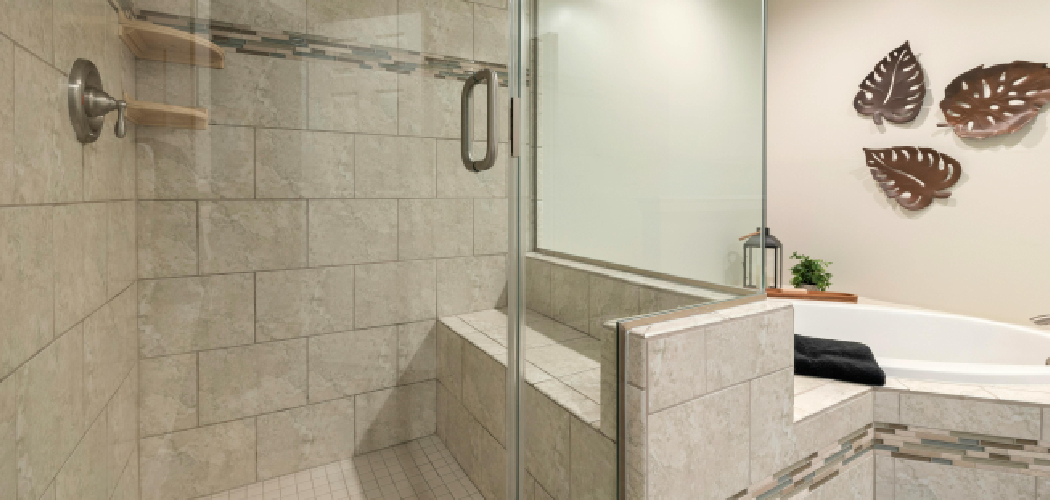Updating a bathroom with beige tile is a project that many homeowners face. Beige tiles, once a staple in bathroom design for their neutrality and warmth, can often feel outdated or bland in modern interiors. However, with the right approach, these tiles can serve as a versatile foundation for a stunning bathroom makeover. This guide will explore how to update a bathroom with beige tile, infusing it with fresh, contemporary style while leveraging the timeless appeal of its beige palette.
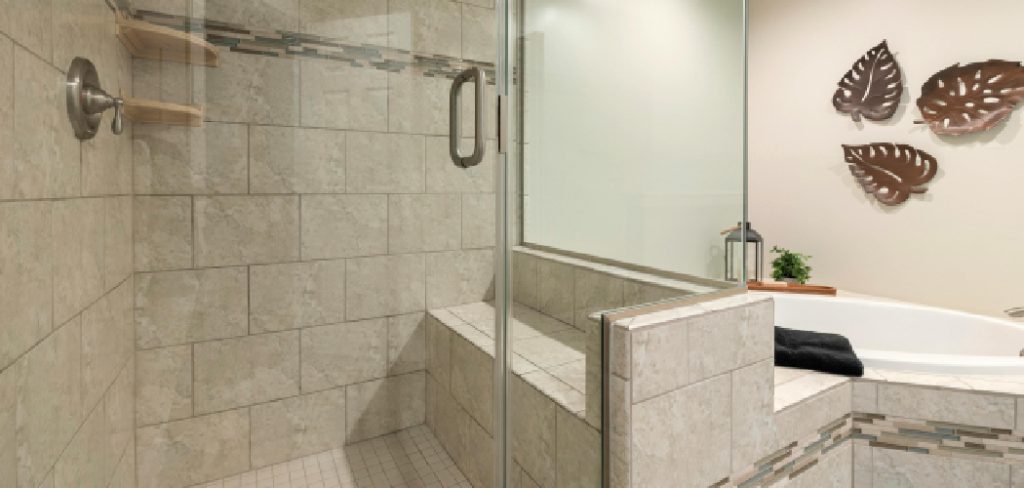
One of the main challenges with beige tile is its tendency to make a bathroom feel uninspired or dated, especially when the rest of the home boasts a more modern or distinctive design. Conversely, the neutral tone of beige tiles presents ample opportunities for creativity. They can complement various colors, materials, and styles, from bold and vibrant to soft and serene. This versatility opens up numerous design possibilities, turning the perceived challenge into a significant advantage.
The process of updating a bathroom with beige tile involves several key steps. Starting with assessing the current state of the tile and bathroom features, one can decide which elements to highlight and which to modify. The subsequent steps include adding contrast with paint, enhancing with accents and accessories, refreshing grout and sealant, and incorporating decorative tiles for added visual interest. Each step offers an opportunity to personalize the space, culminating in a bathroom that looks updated and feels uniquely yours.
Assessing the Current Look
A. Evaluating Beige Tile Condition and Style
The initial step in updating a bathroom with beige tile is to thoroughly evaluate the condition and style of the existing tiles. This involves examining the tiles for any cracks, chips, or discoloration that may have occurred over time. The style of the tile – whether it’s a uniform color, patterned, or textured – also plays a crucial role in determining the new design direction. Recognizing the inherent style and condition of the beige tiles will set the stage for subsequent updates, ensuring they enhance rather than detract from the overall aesthetic.
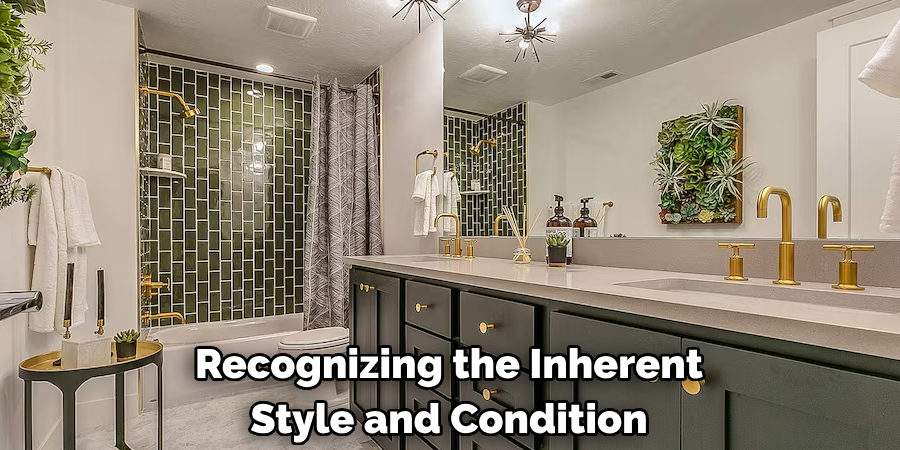
B. Identifying Features to Retain or Highlight
After evaluating the beige tiles, the next step is to identify features within the bathroom that should be retained or highlighted. This can include architectural elements, such as built-in shelving or niches, and existing fixtures or fittings that complement the beige tile. By pinpointing these features, homeowners can create a cohesive design that harmonizes with the beige tiles rather than competing with them. This may also provide inspiration for color schemes, textures, and materials that will be introduced in the updating process.
C. Considering Personal Preferences and Design Goals
Considering personal preferences and design goals is imperative to ensure the updated bathroom reflects the homeowner’s style and meets their needs. This may involve deciding on a specific theme, such as minimalist, modern, or rustic, and determining how the beige tile can support this vision. It also includes considering practical aspects, such as storage needs and lighting requirements. Balancing aesthetic desires with functional necessities will pave the way for a successful update, making the bathroom beautiful and fully suited to the homeowner’s lifestyle.
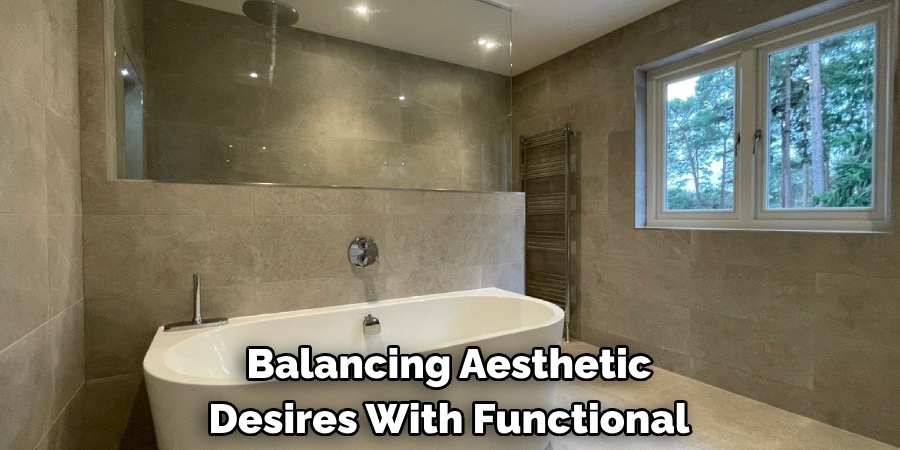
How to Update a Bathroom with Beige Tile: Adding Contrast with Paint
A. Choosing a Paint Color to Complement Beige Tile
Selecting the right paint color is crucial for adding contrast and enlivening a bathroom adorned with beige tile. Cool tones, such as soft grays or crisp whites, can offer a refreshing contrast that highlights the warmth of the beige. For a bolder statement, deeper hues like navy or forest green can introduce a dramatic backdrop, making the beige tiles pop. It’s essential to consider the tile’s undertone—whether it leans more towards yellow, pink, or gray—to ensure the chosen paint enhances and harmonizes with the existing beige tiles. Test swatches on different walls can help visualize how natural and artificial light affects color throughout the day.
B. Applying Paint to Walls, Ceiling, or Cabinets
To infuse the space with personality and charm, consider painting the walls, ceiling, or cabinets. Painting the ceiling in a light color can lift the room’s overall brightness, especially in bathrooms with limited natural light. Accentuating cabinets or vanity units in a contrasting or complementary hue to the beige tiles can anchor the space and add depth. For a cohesive look, choose a satin or semi-gloss finish that is durable and moisture-resistant, making it ideal for the bathroom environment and reflective enough to enhance the room’s overall light.
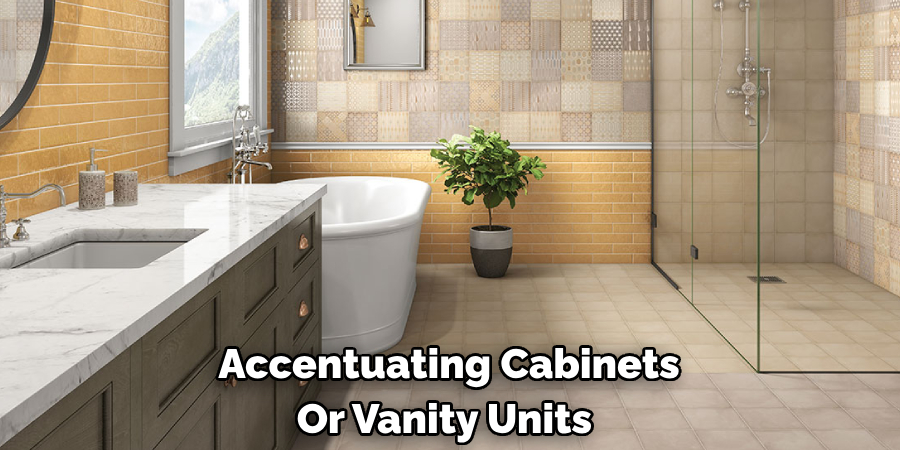
C. Using Paint to Create Depth and Visual Interest
Paint can also be employed creatively to add depth and visual interest to the bathroom. Techniques such as color blocking, stripes, or stenciled patterns can transform bland walls into focal points. For instance, a dark color painted halfway up the wall, topped with a lighter hue, can visually heighten the ceilings and introduce a modern, dynamic aesthetic. Alternatively, a stenciled design over a portion of the wall can add a unique, personalized touch that resonates with the room’s overall theme. These painting strategies enable homeowners to experiment with color and pattern, offering an easy and reversible way to update the look of their beige-tiled bathroom.
How to Update a Bathroom with Beige Tile: Enhancing with Accents and Accessories
A. Introducing Contrasting Colors Through Accessories
One of the simplest yet most effective ways to revitalize a bathroom with beige tiles is by introducing contrasting colors through accessories. Brightly colored towels, rugs, and shower curtains can instantly uplift the room’s ambiance. Consider selecting accessories in vibrant hues such as turquoise, coral, or even rich purples to create eye-catching contrasts that breathe life into the space. These elements serve functional purposes and act as bursts of color that break the monotony of beige, infusing the bathroom with energy and personality.
B. Incorporating Textures and Patterns for Visual Appeal
Textures and patterns are pivotal in adding depth and interest to a bathroom. By incorporating various materials such as wood, metal, woven baskets, and textured fabrics, you can enhance the tactile experience of the space. Patterned bath mats or geometrically designed towels can also add visual intrigue. The key is to balance these textured and patterned accessories against the smooth and neutral backdrop of beige tiles, ensuring the bathroom feels cohesive yet dynamic.
C. Updating Fixtures and Hardware for a Modern Touch
Replacing outdated fixtures and hardware is a quick way to modernize a bathroom and complement the beige tiles with a fresh look. Consider installing new faucets, showerheads, and drawer pulls in contemporary finishes like matte black, brushed nickel, or rose gold. These modern touches not only update the bathroom’s aesthetic appeal but also improve functionality. Opting for fixtures with sleek designs and clean lines can further enhance the room’s modern vibe, making the space feel more refined and elegant.

Refreshing Grout and Sealant
A. Cleaning and Restoring Grout Lines for a Fresh Look
Over time, grout lines between tiles can become discolored and stained, detracting from the bathroom’s overall appearance. A thorough cleaning can restore grout lines to their original color, giving the whole bathroom a cleaner and fresher look. This can be achieved by using a mixture of baking soda and water to create a paste, then applying it to the grout lines and gently scrubbing it with a brush. A specialized grout cleaner may be necessary for stubborn stains. After cleaning, it’s important to allow the grout to dry completely before moving on to sealing.
B. Applying Grout Sealer to Protect and Enhance Appearance
Once the grout is clean and dried, applying a grout sealer is a crucial step to protect it from future staining and to ease maintenance. A quality sealer can also enhance the appearance of the grout, making the colors appear more vibrant. Sealers come in various forms, including spray-on and applicator-based types, and choosing the right one depends on the grout type and personal preference. It is advisable to apply the sealer evenly across all grout lines and allow sufficient drying time as per the manufacturer’s instructions.
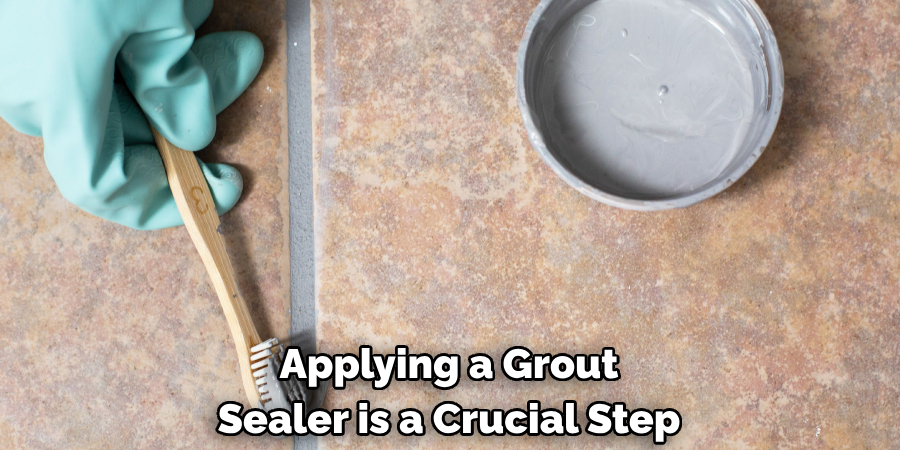
C. Addressing Any Grout Repairs or Maintenance Needs
In addition to cleaning and sealing, inspecting the grout for any cracks or damage is essential. Damaged grout affects the bathroom’s aesthetics and can lead to water damage and tile instability. Small cracks can often be repaired using a grout pen or a small amount of new grout. Removing the old grout and applying new grout may be necessary for more significant damage. Regular maintenance, including periodic cleaning and sealing, will keep the grout in good condition, extend its lifespan, and maintain the bathroom’s polished appearance.
Using Decorative Tile Accents
A. Introducing Decorative Tiles as Accents or Borders
Decorative tiles can significantly enhance the visual appeal of a bathroom, serving as an elegant way to break up the monotony of beige tiles. Introducing accent tiles in strategic locations, like along the border or as a feature strip, adds a touch of sophistication and style. Depending on the desired ambiance, these can range from intricate patterns to bold, contrasting colors. They delineate spaces within the bathroom when used as borders, creating visual interest and drawing the eye toward design highlights.
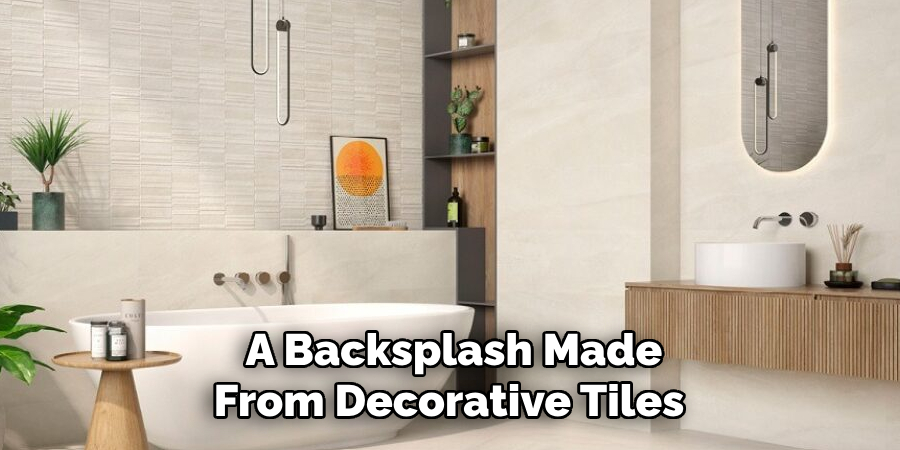
B. Incorporating Mosaic Tiles for Visual Interest
Mosaic tiles, with their diverse colors and textures, offer a unique opportunity to inject personality into the bathroom. These can create a vibrant backsplash behind the sink or cover an entire wall, serving as a stunning focal point. The reflective quality of glass mosaics can also enhance light within the space, making the bathroom appear brighter and more inviting. When paired with the neutrality of beige tiles, mosaics bring a dynamic and artistic element, transforming the space into a visually captivating area.
C. Creating Focal Points with Tiled Niche or Backsplash
A tiled niche or backsplash not only serves a practical purpose but also acts as a decorative feature. In the shower area, a niche can provide convenient storage for toiletries while being framed with decorative tiles to highlight its presence. A backsplash made from decorative tiles above the sink can tie the room’s design together, adding both function and beauty. These elements can range from subtle to bold, depending on the tiles chosen, allowing for personalization of the space that enhances the overall design and coherence of the bathroom.
Installing Statement Lighting
A. Choosing Lighting Fixtures to Complement Beige Tiles
Selecting the right lighting fixtures can play a crucial role in enhancing the aesthetic appeal of a bathroom adorned with beige tiles. To complement the warm undertones of beige, consider lighting fixtures with a soft gold or bronze finish. These colors will add a touch of elegance and create a cozy, welcoming atmosphere. For a more modern look, fixtures in matte black or chrome can offer a striking contrast, accentuating the contemporary elements of the space.
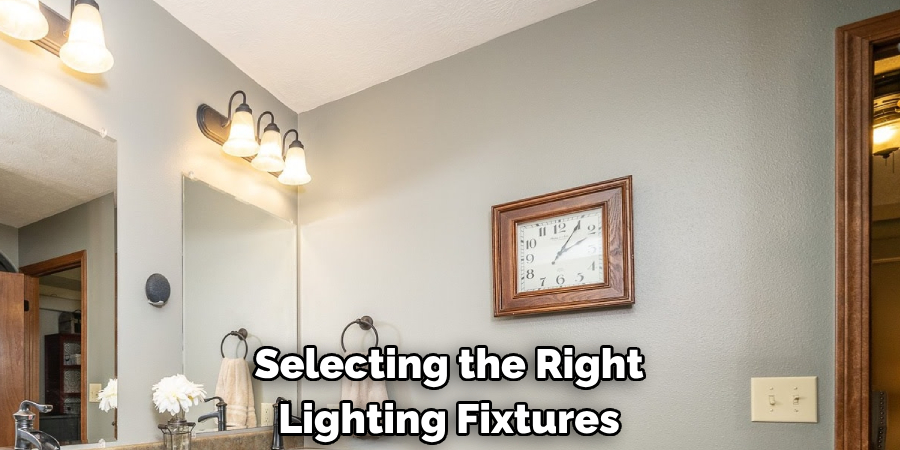
B. Installing Task Lighting for Functionality
Task lighting is essential in a bathroom to illuminate specific areas, such as above the vanity or sink, and facilitate daily grooming activities. LED sconces or pendant lights positioned on either side of the mirror can provide bright, even light, eliminating shadows on the face. It’s important to choose fixtures that offer sufficient luminosity without being harsh, enhancing functionality without compromising on comfort or aesthetic appeal.
C. Adding Ambient Lighting for Atmosphere
Ambient lighting contributes to the overall mood of the bathroom and is crucial for creating a relaxing atmosphere. To achieve a soft, diffused light that fills the room, consider installing recessed lighting in the ceiling or LED strip lighting along the baseboards. Dimmer switches can also be incorporated, allowing light intensity adjustment according to the time of day or desired ambiance. The subtle use of light and shadow can greatly enhance the textures and colors of beige tiles, making the bathroom a soothing retreat.
Incorporating Greenery and Natural Elements
A. Adding Indoor Plants for a Fresh and Natural Touch
Incorporating indoor plants into the bathroom design brings a slice of the outdoors inside, adding vibrancy and a sense of freshness to the space. Not only do they enhance the aesthetic appeal with their lush greenery, but plants like Aloe Vera, Boston Fern, and Snake Plant also thrive in humid environments, purifying the air. Positioning potted plants on open shelves or hanging planters near the window can create a relaxing, spa-like atmosphere, making the bathroom feel more inviting and alive.
B. Using Natural Materials (e.g., Wood, Stone) for Décor
Integrating natural materials such as wood and stone into the bathroom decor contributes to a warm and earthy ambiance. Wooden accents can be introduced through vanity cabinets, shelves, or bath mats, adding a touch of elegance and warmth that beautifully complements the beige tiles. Similarly, stone elements such as marble or granite countertops and pebble bath mats introduce texture and a connection to nature, reinforcing the tranquil and luxurious vibe of the space.
C. Bringing in Natural Light with Sheer Curtains or Blinds
Maximizing natural light in the bathroom elevates the appearance of beige tiles by highlighting their subtle variations and creating an airy, open feeling. Sheer curtains or lightly tinted blinds allow for privacy while softly diffusing sunlight, brightening the room without overwhelming it. This gentle illumination can transform the bathroom into a serene sanctuary, where every moment feels bathed in the soothing glow of natural light.

Customizing with Artwork and Mirrors
A. Hanging Artwork to Add Personality and Style
Introducing artwork into the bathroom is a simple yet powerful way to infuse the space with your personal style and elevate the overall design. Choosing art that reflects your taste can transform a functional area into a more personalized and inviting retreat. When selecting artwork to complement the warm tones of beige tiles, consider pieces with subtle earth tones or pops of color that can serve as accent hues. Water-resistant frames or canvas prints can ensure longevity in the humid environment of a bathroom.
B. Installing Mirrors to Create Illusion of Space and Light
Mirrors are practical for daily routines and play a crucial role in enhancing the spatial and lighting aspects of a bathroom. A strategically placed mirror can amplify light, making the room appear brighter and more spacious. For bathrooms with beige tiles, consider mirrors with frames that either match the beige palette for a cohesive look or contrast it to add visual interest. Large, frameless mirrors can maximize light reflection and create a seamless illusion of extra space.
C. Selecting Pieces that Complement the Beige Tile Aesthetic
The key to enhancing the serene and elegant ambiance of a bathroom with beige tiles lies in selecting artwork and mirrors that harmonize with the existing décor. For artwork, look for pieces incorporating beige and complementary colors or providing a striking contrast without clashing with the palette. Similarly, choosing mirrors with a design or frame that echoes the bathroom style—from minimalist to ornate—can tie the room together. Whether you’re drawn to modern simplicity or rustic charm, the artwork and mirrors should enrich the bathroom’s aesthetic while echoing its tranquil atmosphere.
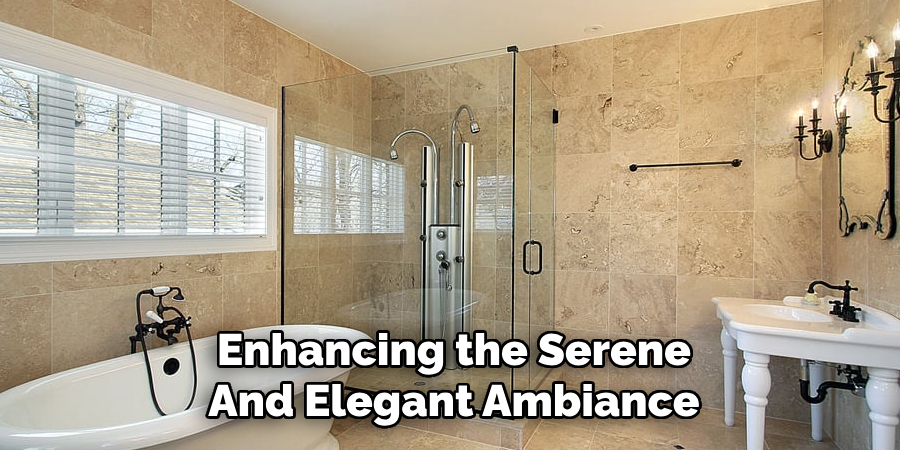
Creating a Spa-Like Atmosphere
A. Incorporating Relaxing Scents and Aromatherapy
Introducing calming scents and aromatherapy is essential to transform a bathroom into a haven of relaxation closely resembling a spa. This can be achieved through the use of essential oil diffusers, scented candles, or reed diffusers with fragrances such as lavender, chamomile, or eucalyptus. These scents have been known to reduce stress, promote relaxation, and enhance mood, creating an immersive experience that engages the senses and soothes the mind.
B. Installing a Rainfall Showerhead or Jetted Tub
Another key element in creating a spa-like atmosphere is incorporating luxurious water features, such as a rainfall showerhead or a jetted tub. A rainfall showerhead mimics the gentle and soothing experience of standing in a soft rain, offering a tranquil escape from daily stresses. Alternatively, a jetted tub provides a therapeutic hydro massage, ideal for relaxing tense muscles and unwinding after a long day. Both options add a touch of indulgence to the bathroom, elevating the bathing experience to new comfort levels.
C. Adding Luxurious Towels and Bathrobes for Comfort
The final touch in crafting a spa-like environment is the provision of plush towels and bathrobes. Investing in high-quality, soft, and absorbent towels and thick, comfy bathrobes enhances the sense of luxury and comfort in the bathroom. These items contribute to the overall aesthetic and envelop the body in warmth and softness, making every post-shower or bath moment feel like a pampering spa experience. Opt for materials like Egyptian or Turkish cotton for the ultimate in opulence and durability.
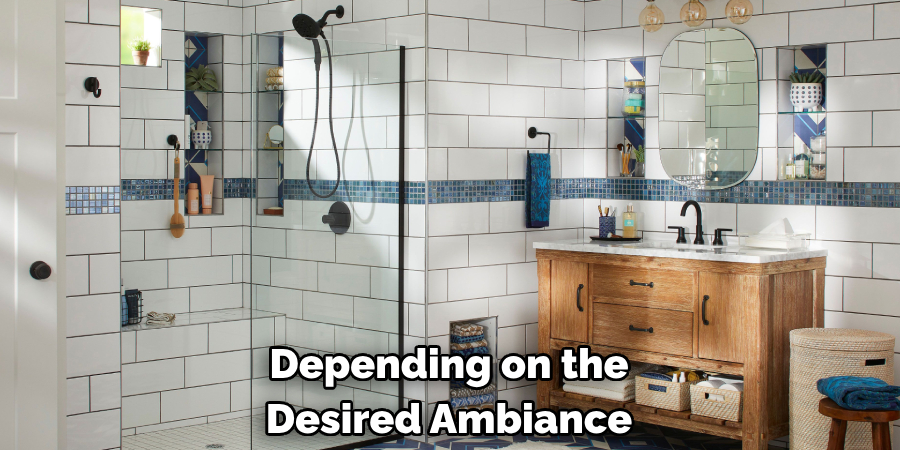
Final Touches and Finishing Details
A. Revisiting the Space to Ensure Cohesiveness
After integrating various elements into your bathroom, revisiting the entire space is crucial to ensure everything harmonizes beautifully. This means examining the coordination between the beige tiles and added features such as plants, natural materials, lighting, artwork, and mirrors. Ensure that the chosen decorations and fixtures complement the tiles and each other, maintaining a cohesive look and feel throughout the space.
B. Making Any Final Adjustments or Additions
With a critical eye, identify areas that might need slight adjustments or additional touches. This could involve rearranging decorative items, changing lighting intensity to better accentuate the beige tiles, or adding small accessories that enhance the spa-like atmosphere. Perhaps a decorative tray for bath salts near the tub or a stylish stool could add both functionality and aesthetic appeal. The goal is to finalize the space, ensuring every element contributes positively to the overall ambiance.
C. Stepping Back to Appreciate the Transformed Space
Once all elements are in place and the final adjustments have been made, take a moment to step back and appreciate your efforts. Observe how the individual components come together to form a harmonious, tranquil, and inviting bathroom. From the practicality of lush plants thriving in the humidity to the luxury of a rainfall showerhead, each detail contributes to a spa-like retreat. Admire how the beige tiles serve as a warm, neutral backdrop that ties everything together, highlighting the importance of cohesion in interior design. This is the moment to savor the transformed space, a testament to thoughtful planning and creativity.
Conclusion
Updating a bathroom with beige tile involves a harmonious blend of elements combining functionality and aesthetic appeal. Each step is pivotal, from incorporating greenery and utilizing natural materials to enhance the earthy vibe to selecting the perfect lighting, artwork, and mirrors to complement the beige palette. The transformation progresses by creating a spa-like atmosphere through relaxing scents, luxurious water fixtures, and soft textiles, all of which enrich the bathroom’s comfort and appeal.
Transforming a bathroom with beige tile into a stylish retreat offers numerous benefits. Not only does it elevate the space’s visual appeal, making it a more enjoyable and relaxing environment, but it also significantly increases the property’s market value. This transformation creates a sanctuary that promotes wellness and relaxation, directly impacting one’s quality of life by offering a daily spa-like experience.
When considering how to update a bathroom with beige tile, focusing on cohesion, personal style, and functionality is essential. Start with a clear vision of the desired outcome and meticulously choose elements contribute to a serene and cohesive look. Incorporate textures and colors that complement the beige tones while adding layers of luxury and comfort through quality fixtures and textiles. Remember, the objective is to balance beauty and utility, making the space both inviting and efficient.

